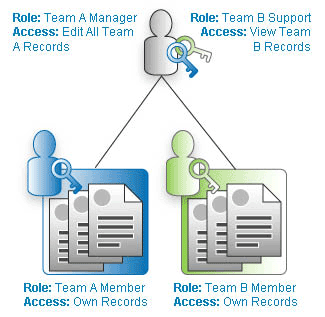Difference between revisions of "Working with Roles"
From LongJump Support Wiki
imported>Aeric |
imported>Aeric |
||
| Line 11: | Line 11: | ||
To Add or Edit a Role: | To Add or Edit a Role: | ||
#Click '''Settings > Administration > Roles.''' The currently defined roles are listed. | #Click '''Settings > Administration > Roles.''' The currently defined roles are listed. | ||
#*The ''System Administrator'' role comes with the platform. | #* The ''System Administrator'' role comes with the platform. | ||
# | #* ''Learn more:'' [[Default Roles]] | ||
#Click the '''[New Role]''' button to add a role; | #Click the '''[New Role]''' button to add a role; | ||
#Optionally, click an existing role to edit the role | #Optionally, click an existing role to edit the role | ||
Revision as of 21:25, 20 June 2012
As organizations grow and evolve, the Default Roles built into the platform may need to adapt to changing business needs.
It is common for new roles to be added over time, and for these roles to evolve (in scope or access permission rights) as the organization grows and business roles change.
Users that have the Access Control/User Management permission can create teams and roles, add users, assign users to teams, and designate access permission rights
Role Management Restrictions
The ability to manager roles is subject to the Permissions Hierarchy restrictions.
Add or Edit a Role
To Add or Edit a Role:
- Click Settings > Administration > Roles. The currently defined roles are listed.
- The System Administrator role comes with the platform.
- Learn more: Default Roles
- Click the [New Role] button to add a role;
- Optionally, click an existing role to edit the role
- Specify the Role Settings (described below)
- Click [Save]
Clone a Role
You can clone a role in order to save time in creating a new role that has similar settings.
To Clone a Role:
- Click Settings > Administration > Roles
- Click the name of the role you want to clone. The detail page for that role opens.
- Click the [Clone] button.
The Add Role page opens, displaying the settings from the Role you cloned. - Specify the Role Settings (described below)
- Click [Save]
Delete a Role
To Delete a Role:
- Click Settings > Administration > Roles
- Click the name of the role you want to delete; the detail page for that role opens
- Click the [Delete] button at the top of the page.
A confirmation dialog appears. - Click [OK] to delete the role.
Role Settings
Role Information
- Name
- The name of the role as it will appear in the platform
- Description
- Text that describes this role and its settings (permissions)
Login IP Address Restrictions
- IP Address Ranges
- For extra security, enter ranges of IP addresses from which users with this Role are allowed to access the platform.
Global and Individual Permissions Tabs
Use these tabs to set up global and individual-object and individual platform-element permissions, as described in the next section.
